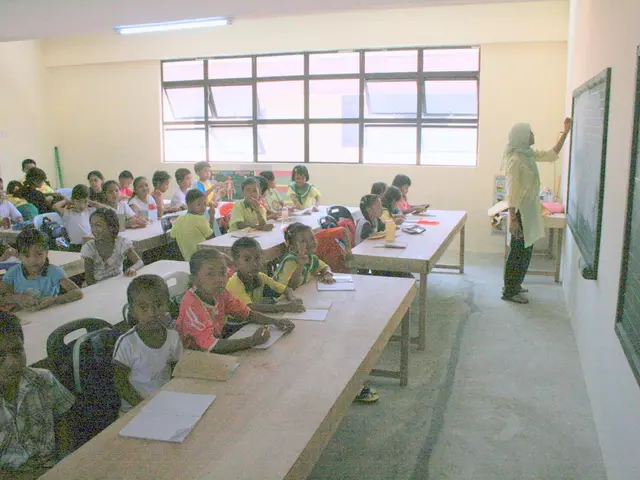Discovering a Less Physical Approach to Raising Well-Behaved Children
Alternative Methods of Behavior Modification Without Resorting to Physical Discipline: 10 Practical Strategies for Non-Violent Correction
Mastering what it takes to discipline children without physical force is essential for parents seeking to foster emotionally secure, well-mannered young ones. Traditional methods such as spanking and other physical reprimands could lead to long-term emotional harm and hinder a child's development. Instead, consider these 10 innovative strategies for correcting behavior without resorting to physical punishment.
Grasping the Harmful Effects of Physical Punishment
Before exploring effective methods to discipline without physical force, it's crucial to understand the potential drawbacks of using physical discipline. Although it might appear to offer immediate results, physical punishment can have negative long-term consequences, such as aggression, emotional insecurity, and an erosion of trust. Research shows that children exposed to physical punishment are more prone to behavioral issues and may struggle with emotional regulation as adults [1].
By choosing not to physically discipline, parents create an atmosphere of respect and safety that nurtures emotional growth and strong relationships with their children.
What It Takes to Discipline Kids Without Physical Force: Setting Rules and Boundaries
Setting clear parameters for behavior is the first step in learning what it takes to discipline without physical force. Children need rules and expectations to avoid misbehaving in the first place and create a stable environment in which they feel secure. To make this tactic effective, parents should communicate the rules calmly and consistently. For example, you could explain that certain actions, like yelling, are harmful because they hurt others [2]. When children grasp why rules exist, they are more likely to comply.
Confidently Rearing Children Through Positive Reinforcement
One potent approach to disciplining kids without physical force is positive reinforcement. This strategy involves rewarding good behavior rather than punishing bad behavior. When children receive praise, rewards, or privileges for positive actions, they are more likely to repeat those behaviors in the future. For instance, if a child helps clean up toys, acknowledge their effort with praise or offer them a favorite snack as a reward [2]. Positive reinforcement teaches children that the right choices produce positive outcomes, fostering self-discipline without intimidation or punishment.
Using Time-Outs as a Reflection Tool in Disciplining Without Physical Force
Time-outs can be an effective strategy for disciplining children without physical force when used correctly. Instead of administering punishment, view time-outs as an opportunity for children to process their emotions and learn from their mistakes. Set up a quiet, designated space where the child can sit for a few minutes to calm down and reflect. Keep it a peaceful setting and avoid punitive language [3]. Afterward, engage in a calm, empathetic conversation regarding the behavior and how it can be improved in the future.
Implementing Logical Consequences in Disciplining Without Physical Force
One of the most productive techniques for disciplining children without physical force involves imposing logical consequences. Logical consequences directly connect a child's actions to their outcomes, helping them understand the relationship between behavior and its consequences. For example, if a child refuses to finish homework, a logical consequence might be a reduction in screen time until it's completed [3]. This approach teaches children accountability in a manner that is constructive and not based on fear.
Utilizing Empathy and Communication for Disciplining Without Physical Force
Communicating with empathy is essential when examining ways to discipline children without physical force. Often, misbehavior originates from emotions that children have difficulty expressing. By taking the time to listen and understand their feelings, parents can create an atmosphere in which open communication thrives and misbehavior is significantly reduced. Instead of reacting negatively, approach the child with empathy. Ask open-ended questions such as "How do you feel about what happened?" or "Why did you behave that way?" By acknowledging their emotions, parents can help children develop emotional intelligence and reduce the likelihood of future issues.
Offering Options in Disciplining Without Physical Force
Another valuable method for disciplining children without physical force is offering choices. Children feel empowered when they have some control over the situation, which encourages cooperation rather than resistance. Provide choices when possible, like "Do you want to clean up before or after dinner?" This enables children to take responsibility for their actions without resorting to punishment.
Setting an Example to Discipline Without Physical Force
When exploring methods to discipline children without physical force, it's essential to remember the impact of role models. Children often mimic the actions of adults, especially parents. If parents maintain control and manage stress effectively, children are more likely to adopt those qualities [1]. Demonstrate good behavior, manage conflicts calmly and respectfully, and keep emotional Regulation under control to set a lasting example for your child.
Cultivating Emotional Expression to Discipline Without Physical Force
Guiding children in expressing their emotions constructively is another fundamental aspect of disciplining without physical force. Misbehavior can result when children are unable to articulate their feelings appropriately [3]. Encourage emotional expression by providing a safe space for children to discuss their emotions. Use open-ended questions such as "What's bothering you?" or "What's making you angry?" This approach helps children discover healthy ways to express themselves and reduces the chance of future misbehavior.
Building Consistency to Discipline Without Physical Force
Consistency is a critical component when considering ways to discipline children without physical force. Children require consistency to understand rules and the consequences of breaking those rules. Inconsistent discipline can confuse children and hinder their ability to learn the rules [3]. Strive to maintain consistency in discipline, ensuring both parents are on the same page. This consistent approach establishes a stable environment in which children understand what is expected of them.
Conclusion
Armed with the knowledge of how to discipline children without physical force, parents can cultivate emotionally secure, respectful, and well-adjusted offspring. By embracing strategies like positive reinforcement, effective communication, time-outs, and logical consequences, parents can guide children toward improved behavior while fostering a close, harmonious bond. These alternative techniques not only avoid the negative consequences associated with physical punishment but also cultivate emotional growth and mutual respect.
Frequently Asked Questions
- How can I discipline toddlers without physical force? Offering choices, setting clear boundaries, and using positive reinforcement can be effective methods for disciplining young children. These approaches help toddlers understand expectations without resorting to physical punishment.
- Why is positive reinforcement so important when disciplining without physical force? Positive reinforcement encourages children to repeat positive behavior by rewarding it. This strategy fosters self-discipline and creates a positive atmosphere within the family.
- What are logical consequences, and how can they help in disciplining without physical force? Logical consequences maintain a direct connection between a child's actions and their consequences, teaching children the natural outcomes of their choices and fostering a sense of responsibility.
- How can empathy improve discipline when disciplining without physical force? Empathy allows parents to connect with a child's emotions, creating a connection that leads to cooperation. This approach helps children feel supported and understood.
- How can time-outs be used to discipline without physical force? Time-outs offer children the opportunity to calm down and reflect on their actions in a peaceful setting. Properly implemented, time-outs promote self-regulation and emotional intelligence.
- How can consistency be useful in disciplining without physical force? Consistency ensures that rules and consequences are applied fairly and predictably. This approach helps children learn the rules and understand what is expected of them, which supports long-term behavior change.
[1] Harvard Health Publishing. (2017). Strategies that matter most in child-rearing: The evidence on effective parenting. Retrieved from https://www.health.harvard.edu/parents/parenting-tips/strategies-that-matter-most-in-child-rearing-the-evidence-on-effective-parenting
[2] National Institute of Child Health and Human Development. (2018). Effective Discipline Strategies. Retrieved from https://www.nichd.nih.gov/health/topics/discipline/index.cfm
[3] Cleland, C. M., Davis, M. W., & Goldstein, N. P. (2013). Evidence-based parenting programs: A review of systematic reviews of interventions for parents and caregivers with children ages 0-8. Journal of Consulting and Clinical Psychology, 81(5), 808-819. doi:10.1037/a0033973
- Maintaining consistency in setting and enforcing rules is crucial in fostering emotional growth and strong relationships with children, as it establishes clear boundaries and helps children understand what is expected of them.
- By communicating with empathy and promoting emotional expression, parents can create an environment where children feel safe to express their feelings and reduce the likelihood of misbehavior in the future.
- Respect is essential in parenting, and using science-based, health-and-wellness strategies, such as positive reinforcement and logical consequences, helps children learn self-discipline without fear or intimidation while promoting a harmonious and loving relationship between parent and child.







